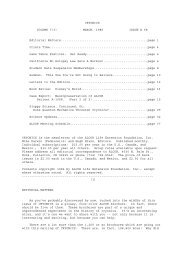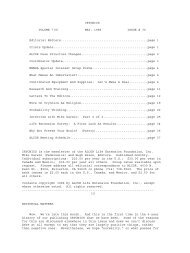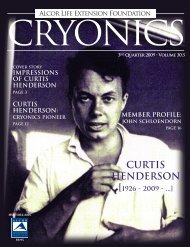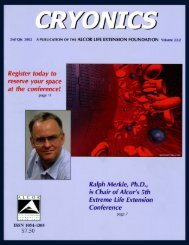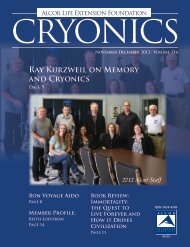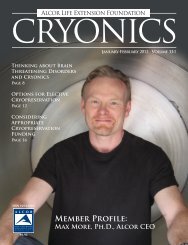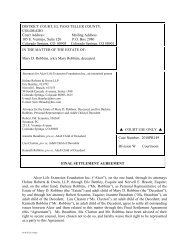Robert Ettinger - Alcor Life Extension Foundation
Robert Ettinger - Alcor Life Extension Foundation
Robert Ettinger - Alcor Life Extension Foundation
Create successful ePaper yourself
Turn your PDF publications into a flip-book with our unique Google optimized e-Paper software.
ice shipping. (This could also be used for<br />
overseas whole body members, although<br />
cryoprotection might initially be limited to<br />
the brain.) The benefits of this approach<br />
to neurocryopreservation is that it allows<br />
<strong>Alcor</strong> to provide cryoprotection to its foreign<br />
members; it greatly reduces or eliminates<br />
ice-temperature ischemic transport<br />
time (this means that a cryoprotection will<br />
take less than 8 hours from pronouncement<br />
to beginning of descent to dry ice<br />
temperature, eliminating 6 to 30 hours of<br />
ice temperature transit time); and it eliminates<br />
uncertainties related to the time requirements<br />
of ice transport, such as transit<br />
permits and airline schedules.<br />
The Expanded Role of Suspended<br />
Animation<br />
We can effectively pursue the goals<br />
of heightened resilience and continuous<br />
improvements not only internally but also<br />
by partnering with other organizations with<br />
high standards. <strong>Alcor</strong> has been making use<br />
of the services of Florida-based Suspended<br />
Animation for some time. At the recent<br />
Strategic Meeting we saw a presentation<br />
by SA and some of their contract medical<br />
personnel that led to a new policy calling<br />
for more extensive use of SA’s standby and<br />
transport services. The funding available to<br />
SA means they have been able to develop<br />
capabilities not available to <strong>Alcor</strong>.<br />
SA now has a network of cardiothoracic<br />
surgeons and clinical perfusionists that<br />
they will be attempting to deploy for all their<br />
cases. <strong>Alcor</strong> adopted a policy of attempting<br />
to use SA for all <strong>Alcor</strong> cases in the continental<br />
U.S. outside of Arizona for which they<br />
are available and for which their services<br />
are clinically indicated. <strong>Alcor</strong> staff and ACT<br />
teams will still be used as emergency first<br />
responders. Aaron Drake may sometimes<br />
accompany the SA team. Catherine Baldwin<br />
(SA’s Chief Operating Officer) was added<br />
to the <strong>Alcor</strong> Deployment Committee and<br />
made an advisor to the <strong>Alcor</strong> Board.<br />
Solving Underfunding and Inflation<br />
<strong>Alcor</strong> has many members who made<br />
cryonics arrangements years ago when<br />
minimum funding levels were substantially<br />
lower. Unfortunately, those members<br />
(around two-thirds of all members) mostly<br />
did not plan to provide for increased funding<br />
to match rising costs resulting from<br />
inflation and new, more expensive procedures.<br />
<strong>Alcor</strong> has also been at fault for fail-<br />
ing to sufficiently strongly emphasize the<br />
need to provide more funding than current<br />
minimums. As a result, as deeply underfunded<br />
members are cryopreserved, <strong>Alcor</strong><br />
faces huge losses that threaten the survival<br />
of the organization.<br />
I cannot emphasize enough that<br />
prices will go up! At a modest annual<br />
inflation rate of 3%, prices double every<br />
24 years. If you will not need cryopreservation<br />
for another 48 years, at historically<br />
average inflation rates, a cryopreservation<br />
cost of $80,000 in 2011 will end up costing<br />
$320,000. And there’s no guarantee that<br />
rates won’t go up more than that, either due<br />
to higher average inflation or because the<br />
cost of cryonics procedures goes up more<br />
than general inflation (a situation familiar<br />
in the medical field). Every <strong>Alcor</strong> member<br />
should plan to take measures such as:<br />
• Providing funding well over current<br />
minimums<br />
• Adding additional life insurance funding<br />
over time.<br />
• Selecting an insurance policy that provides<br />
some inflation protection by<br />
building value over time and by reinvesting<br />
returns.<br />
<strong>Alcor</strong> must do more than hope<br />
that members take these actions. After<br />
months of detailed deliberation, we have<br />
come up with a range of possible solutions,<br />
one of which seems to us the most<br />
promising. Every member should read<br />
the article on Underfunding and Inflation<br />
[http://www.alcor.org/Library/html/<br />
CryopreservationFundingAndInflation.<br />
html]. During the three-month discussion<br />
period, we urge everyone to comment on<br />
the proposal and tell us if you think you<br />
have a better solution. Send your thoughts<br />
to us privately or post them on the new<br />
<strong>Alcor</strong> Forum.<br />
Getting the Word Out<br />
Barry Aarons has long helped <strong>Alcor</strong> remain<br />
on top of potentially damaging legislation<br />
and political developments. Part of this<br />
has meant <strong>Alcor</strong> leaders meeting with local<br />
politicians, so that they know our faces and<br />
are less likely to introduce or support legislation<br />
or regulations harmful to our operations<br />
and our patients. We have remarkably<br />
good relations with primarily conservative<br />
Arizona politicians. It now turns to me to<br />
maintain this favorable status.<br />
Barry is also helping us deploy the<br />
<strong>Alcor</strong> Speakers’ Bureau to give talks to<br />
organizations in the area. Last week, we<br />
started this effort modestly with me giving<br />
a talk to the Midtown Lion’s Club. The goal<br />
is to build a reputation and have a voice in<br />
the influential local business groups.<br />
Since last issue, I made several major<br />
trips. The first of these was a networking trip<br />
to Northern California. There I visited and<br />
talked to those involved in four organizations,<br />
each of which included several <strong>Alcor</strong><br />
members: Halcyon Molecular, Singularity<br />
University, SENS <strong>Foundation</strong> (Strategies<br />
for Engineered Negligible Senescence), and<br />
BioTime. Halcyon has a number of <strong>Alcor</strong><br />
members. The principals of the company<br />
and I discussed the possibility of making<br />
<strong>Alcor</strong> membership a company benefit (subsidizing<br />
or covering the dues).<br />
The second trip was to Cambridge,<br />
England for the fifth SENS conference, organized<br />
by <strong>Alcor</strong> member Aubrey de Grey.<br />
On the afternoon of Saturday September 3,<br />
I gave a talk on “Cryonic <strong>Life</strong> <strong>Extension</strong>”.<br />
This placed cryopreservation in the context<br />
of regenerative medicine and our shared<br />
goals. All signs suggest that the talk was<br />
well received—something I was unsure of,<br />
given that much of the audience now consists<br />
of mainstream researchers who may<br />
have been unfamiliar with the idea. Several<br />
people said they had been thinking about<br />
signing up, but would now definitely do so.<br />
We may even receive funding for research<br />
or other projects.<br />
The third trip was a visit to Cryonics<br />
Institute in Michigan in mid-September.<br />
For details on this, please see <strong>Alcor</strong> News<br />
for September. [http://www.alcor.org/<br />
blog/?m=201109]<br />
Smartening Up<br />
This coming week, the October <strong>Alcor</strong><br />
News will have a more detailed (and illustrated)<br />
report on upgrades to the building.<br />
Last year, when I walked into <strong>Alcor</strong>, I<br />
felt like I was about to walk straight into a<br />
cubicle wall. The space felt crowded, dingy,<br />
and unwelcoming.<br />
The entire area has been repainted, including<br />
the chipped baseboards and around<br />
the doors. We tore out the cubicle closest<br />
to the door and we turned the area created<br />
into a reception area that includes a sofa,<br />
chairs, and table that are stylish without being<br />
expensive, a convincing synthetic plant<br />
(real ones don’t get enough light in that po-<br />
www.alcor.org Cryonics/Fourth Quarter 2011 7



